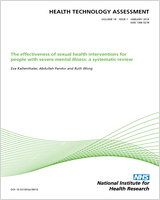Included under terms of UK Non-commercial Government License.
NCBI Bookshelf. A service of the National Library of Medicine, National Institutes of Health.
Abstract
Background:
Imatinib dose escalation is advocated for gastrointestinal stromal tumour (GIST) treatment, but its effectiveness compared with sunitinib and best supportive care (BSC) after failure at the 400 mg/day dose is unknown.
Objectives:
To assess the effectiveness and cost-effectiveness of imatinib at escalated doses of 600 or 800 mg/day for patients with unresectable and/or metastatic GISTs whose disease had progressed on 400 mg/day.
Data sources:
Electronic databases, including MEDLINE, MEDLINE In-Process, EMBASE, BIOSIS, Science Citation Index, Health Management Information Consortium and the Cochrane Controlled Trials Register, were searched until September 2009.
Review methods:
A systematic review of the literature was carried out according to standard methods. An economic model was constructed to assess the cost-effectiveness of seven alternative pathways for treating patients with unresectable and/or metastatic GISTs.
Results:
Five primary studies involving 669 people were included for clinical effectiveness; four reported imatinib and one reported sunitinib. The data were essentially observational as none of the studies was designed to specifically assess treatment of patients whose disease had progressed on 400 mg/day imatinib. For 600 mg/day imatinib, between 26% and 42% of patients showed either a partial response (PR) or stable disease (SD). Median time to progression was 1.7 months (range 0.7–24.9 months). For 800 mg/day imatinib, between 29% and 33% of patients showed either a PR or SD. Median overall survival (OS) was 19 months [95% confidence interval (CI) 13 to 23 months]. Progression-free survival ranged from 81 days to 5 months (95% CI 2 to 10 months). Median duration of response was 153 days (range 37–574 days). Treatment progression led to 88% discontinuations but between 16% and 31% of patients required a dose reduction, and 23% required a dose delay. There was a statistically significant increase in the severity of fatigue (p < 0.001) and anaemia (p = 0.015) following dose escalation. For sunitinib, median OS was 90 weeks (95% CI 73 to 106 weeks). For the cost-effectiveness review, only one full-text study and one abstract were identified, comparing imatinib at an escalated dose, sunitinib and BSC, although neither was based on a UK context. The definition of BSC was not consistent across the studies, and the pattern of resources (including drugs for treatment) and measures of effectiveness also varied. Within the model, BSC (assumed to include continuing medication to prevent tumour flare) was the least costly and least effective. It would be the care pathway most likely to be cost-effective when the cost per quality-adjusted life-year threshold was < £25,000. Imatinib at 600 mg/day was most likely to be cost-effective at a threshold between £25,000 and £45,000. Imatinib at 600 mg/day followed by further escalation followed by sunitinib was most likely to be cost-effective at a threshold > £45,000.
Limitations:
The evidence base was sparse, data were non-randomised and potentially biased. The economic model results are surrounded by a considerable degree of uncertainty and open to biases of unknown magnitude and direction.
Conclusions:
Around one-third of patients with unresectable and/or metastatic GIST, who fail on 400 mg/day of imatinib, may show response or SD with escalated doses. Between a threshold of £25,000 and £45,000, provision of an escalated dose of imatinib would be most likely to be cost-effective. However, these results should be interpreted with caution owing to the limited evidence available on outcomes following imatinib dose escalation or sunitinib for this group of patients.
Funding:
The National Institute for Health Research Health Technology Assessment programme.
Contents
- NIHR Health Technology Assessment programme
- List of abbreviations
- Note
- Executive summary
- 1. Background
- 2. Definition of the decision problem
- 3. Critique of the manufacturer submission
- 4. Assessment of clinical effectiveness
- 5. Assessment of cost-effectiveness
- 6. Assessment of factors relevant to the NHS and other parties
- 7. Discussion
- 8. Conclusions
- Acknowledgements
- References
- Appendix 1 Search strategies
- Appendix 2 Full-paper screening tool
- Appendix 3 Data extraction form
- Appendix 4 Quality assessment tool
- Appendix 5 Information on the reasons for exclusion
- Appendix 6 List of included studies
- Appendix 7 Protocol (4 September 2009, HTA 09/21/01)
- Appendix 8 Characteristics of included studies
- Appendix 9 Quality assessment of the individual full-text studies
- Appendix 10 Search strategies for review of economic analysis studies, cost-effectiveness analysis
- Appendix 11 Summary of the included economic analysis and economic evaluation studies
- Appendix 12 Model structure
- Appendix 13 Alternative best supportive care survival estimates
- Health Technology Assessment programme
Suggested citation:
Hislop J, Quayyum Z, Elders A, Fraser C, Jenkinson D, Mowatt G, et al. Clinical effectiveness and cost-effectiveness of imatinib dose escalation for the treatment of unresectable and/or metastatic gastrointestinal stromal tumours that have progressed on treatment at a dose of 400 mg/day: a systematic review and economic evaluation. Health Technol Assess 2011;15(25).
Declared competing interests of authors: none
The research reported in this issue of the journal was commissioned and funded by the HTA programme on behalf of NICE as project number 09/21/01. The protocol was agreed in October 2009. The assessment report began editorial review in March 2010 and was accepted for publication in October 2010. The authors have been wholly responsible for all data collection, analysis and interpretation, and for writing up their work. The HTA editors and publisher have tried to ensure the accuracy of the authors' report and would like to thank the referees for their constructive comments on the draft document. However, they do not accept liability for damages or losses arising from material published in this report.
The views expressed in this publication are those of the authors and not necessarily those of the HTA programme or the Department of Health.
